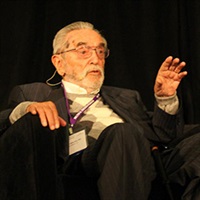EP13 Invited Keynote 03 - How to Produce Change - Salvador Minuchin, MD
- Average Rating:
- Not yet rated
- Topic Areas:
- Keynotes | Family Therapy | Therapist Development | Psychotherapy
- Categories:
- Evolution of Psychotherapy | Evolution of Psychotherapy 2013 | Pioneers in Couples and Family Therapy
- Faculty:
- Salvador Minuchin, MD
- Course Levels:
- Master Degree or Higher in Health-Related Field
- Duration:
- 43:07
- Format:
- Audio and Video
- Original Program Date:
- Dec 12, 2013
- License:
- Never Expires.
Description
Description: Minuchin shares video from an early meeting with a family to demonstrate key concepts in action. He reflects on how therapists can disrupt entrenched patterns, use language strategically, and create space for new roles and dynamics to emerge. The session illustrates how families themselves become agents of change—and how therapists evolve alongside them.
Syllabus Description: Dr. Minuchin will show segments from a first session he conducted with a family, highlighting the concepts that underlie the techniques; the ways that he, as the therapist, assess his interventions; and the impact the family has on him.
Educational Objectives:
- Describe the expanded concept of “the identified patient.”
- Explain how the therapist challenges a family constructively.
- Explain how silence can be used as a therapeutic instrument?
*Sessions may be edited for content and to preserve confidentiality*
Credits
Faculty

Salvador Minuchin, MD Related Seminars and Products
Salvador Minuchin, MD, developed Structural Family Therapy, which addresses problems within a family by charting the relationships between family members, or between subsets of family. He was Director of the Philadelphia Child Guidance Clinic. Although it was minimally staffed when he began, under his tutelage the Clinic grew to become one of the most modeled and respected child guidance facilities in the world. In 1981, Minuchin began his own family therapy center in New York. After his retirement in 1996, the center was renamed the Minuchin Center. Dr. Minuchin is the author of many notable books, including many classics. His latest is Mastering Family Therapy: Journeys of Growth and Transformation. In 2007, a survey of 2,600 practitioners named Minuchin as one of the ten most influential therapists of the past quarter-century.


